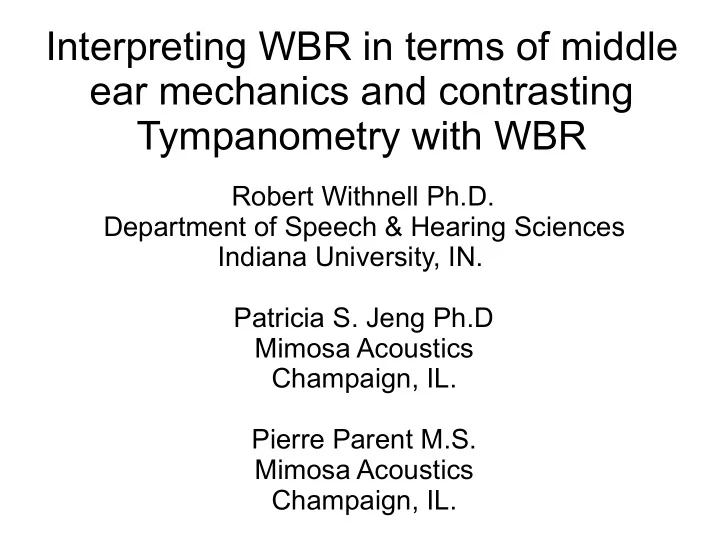

Interpreting WBR in terms of middle ear mechanics and contrasting Tympanometry with WBR Robert Withnell Ph.D. Department of Speech & Hearing Sciences Indiana University, IN. Patricia S. Jeng Ph.D Mimosa Acoustics Champaign, IL. Pierre Parent M.S. Mimosa Acoustics Champaign, IL.
ABSTRACT Wideband reflectance (WBR) and tympanometry both provide a measure of the impedance of the middle ear. Tympanometry has been the standard tool for assessing middle ear function for many years. WBR provides a precise, broad spectrum assessment of middle ear function. WBR patterns can be interpreted in terms of the mechanics of the middle ear, pathology producing predictable alterations in WBR patterns. WBR and tympanometry will be discussed in terms of i. how they work, ii. what they measure, and iii. the relationship between WBR and tympanometry.
The Human Ear Human audiogram http://www.learningthroughlistening.org Suzuki & Takeshima, 2004, JASA, 116(2) ● Hearing thresholds are frequency-dependent ● Outer and middle ear contribute significantly to this frequency-dependence (Dallos, 1971) ● Sound is filtered by the outer and middle ear before being received by the cochlea
Filtering Sound ● High-pass filter – spring + friction – e.g., eardrum = spring, motion of eardrum in air produces friction ● Low-pass filter – mass + friction – e.g., ossicles = mass, motion in air of middle ear space = friction ● Tuned filter – mass + spring + friction – e.g., middle ear of lizard
The Lizard Middle Ear ● A simple mass-spring system with a single resonant frequency ● Lizard middle ear consists of only one ossicle (not three) ● Lizard middle ear simpler than human middle ear with a narrower frequency Werner et al, 2002, J. Exp. Biol. 205 response
The Human Middle Ear Transmitted Sound Incident Sound Reflected Sound ● A broad-band frequency response Hypothetical middle ear frequency response
How do we get from here to here ?
A simple interpretation Lizard Middle Ear Human Middle Ear A tuned filter A bank of tuned filters friction friction elements mass masses spring springs Damping produces a broad transfer function
The Middle ear and Reflectance Z o = c A Transmitted Sound Incident Sound Reflected Sound ● The amount of sound reflected from the eardrum is determined by the impedance mismatch between the ear canal and the middle ear ● We can examine this reflected sound energy using – Power Reflectance ● with our middle ear model (and a value for Zo)
Power Reflectance Stiffness dominated region of middle ear POWER REFLECTANCE MIDDLE EAR TRANSFER FUNCTION
Power Reflectance - role of damping in the middle ear - Stiffness dominated region Plateau region of middle ear of middle ear transfer function POWER REFLECTANCE As damping decreases, response becomes MIDDLE EAR peakier in plateau TRANSFER region FUNCTION First local resonance of middle ear @ approx 1 kHz
Power Reflectance - increase in stiffness of middle ear - POWER REFLECTANCE MIDDLE EAR TRANSFER FUNCTION Power reflectance results from a subject with otosclerosis (Allen et al., 2005)
Power Reflectance - decrease in stiffness of middle ear - POWER REFLECTANCE MIDDLE EAR TRANSFER FUNCTION Power reflectance results from a subject with middle ear disease as a child (Mimosa data)
Power Reflectance - what about OME? - middle ear not fluid-filled mostly INCREASE in M.E. stiffness POWER REFLECTANCE Power reflectance results from a subjects with otitis MIDDLE EAR media with effusion (Allen et TRANSFER al., 2005) FUNCTION
Power Reflectance - Acoustic Leak - No acoustic leak, eartip inserted correctly Foam tip gradually expanding, reducing acoustic leak Acoustic leak If eartip is not acoustically sealed in ear canal, sound at low frequencies leaks out, affecting the calculation of reflectance
Measuring the impedance mismatch between the ear canal and middle ear Obtain Ye and R POWER REFLECTANCE TYMPANOMETRY Sound travels along ear canal Z source Z load Calibrate to find Measure this (sound pressure this in ear canal) TYMPANOMETRY A simple volume ● Measure sound in ear canal Do not ● Pressurize ear canal (make Zme really big) know this and measure sound again ● From two measurements of sound, obtain Yme (admittance of middle ear) Measure this (sound pressure ● Yme = Ye ─ Yec in ear canal)
WBR vs Tympanometry Increasing static pressure in ear canal = increasing stiffness of middle ear 250 Hz probe tone
WBR vs Tympanometry Increasing static pressure in ear canal = increasing stiffness of middle ear 1000 Hz probe tone
Power Reflectance ● Provides a broad spectrum measure of the impedance mis-match between the ear canal and middle ear ● Does not require static pressure changes in the ear canal ● The reflectance transfer function alters predictably with middle ear pathology
Recommend
More recommend